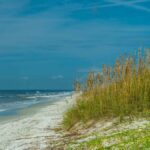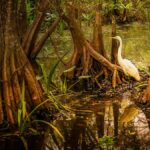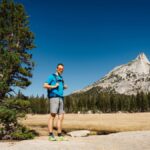Welcome to our guide on wildlife photography, where we will share essential tips and tricks to help you capture breathtaking photographs of nature’s most incredible creatures. Whether you’re a seasoned wildlife photographer or just starting out, we have techniques that will enhance your skills and bring your wildlife shots to life.
There’s something magical about capturing the beauty and rawness of wildlife through the lens of a camera. It allows us to connect with nature on a deeper level and share these captivating moments with others. With our expert advice, you’ll learn how to navigate the challenges that come with photographing wildlife and create images that truly speak to the viewer.
From understanding the equipment you need for wildlife photography to mastering composition, lighting, and timing, we’ll cover it all. We’ll also discuss ethical practices to ensure the well-being of the animals we photograph, as well as post-processing techniques to enhance the impact of your images.
Whether you dream of capturing the majesty of a lion on the African savannah or the graceful flight of a bird in your own backyard, our guide will equip you with the knowledge and techniques to make it happen. Let’s embark on this exciting journey together and unlock the secrets of captivating wildlife photography.
Understanding Wildlife Photography Equipment
Before embarking on your wildlife photography adventures, it’s crucial to familiarize yourself with the essential gear that will help you capture stunning images of the natural world. Having the right equipment can make all the difference in achieving the desired results. Here, we’ll discuss the must-have wildlife photography gear that every enthusiast should consider.
1. Cameras
A quality camera is the backbone of any wildlife photographer’s toolkit. Look for a camera that offers a high resolution and fast autofocus capabilities to capture fast-moving animals. DSLR and mirrorless cameras are popular choices among wildlife photographers due to their versatility and image quality.
2. Lenses
Investing in a good wildlife photography lens is crucial to getting close-up shots of distant or skittish subjects. A telephoto lens with a long focal length, such as 300mm or higher, will allow you to capture detailed shots from a safe distance. Wide-angle lenses can also come in handy for capturing animals in their natural habitats.
3. Tripods and Monopods
Stability is key in wildlife photography, especially when using long telephoto lenses. Tripods and monopods provide a steady platform to prevent camera shake and allow for longer exposure times. Look for lightweight, sturdy options that are easy to carry around in the field.
4. Accessories
There are several accessories that can enhance your wildlife photography experience. These include:
- Camera bag: Invest in a durable and comfortable camera bag to protect your gear during transport and in inclement weather.
- Filters: Filters like polarizers and neutral density filters can help control reflections and balance exposure in challenging lighting conditions.
- Remote shutter release: A remote shutter release eliminates camera shake when capturing wildlife from a distance and allows for improved timing of shots.
- Batteries and memory cards: Always carry extra batteries and memory cards to avoid missing out on precious wildlife moments.
Remember, the specific equipment you choose will depend on your budget, shooting style, and the wildlife you plan to photograph. Research and test different options to find the gear that suits your needs best. With the right wildlife photography gear in your arsenal, you’ll be well-prepared to capture unforgettable moments in the natural world.
Choosing the Best Wildlife Photography Locations
When it comes to capturing stunning wildlife photographs, choosing the right location is key. The United States offers a plethora of diverse habitats and breathtaking landscapes that provide ideal settings for wildlife photography enthusiasts. Whether you’re searching for rare species or magnificent vistas, these best wildlife photography locations are sure to inspire your photography adventures.
- Yellowstone National Park, WyomingKnown as the first national park in the United States, Yellowstone is an iconic destination for wildlife photography. From grizzly bears to wolves and majestic elk, this park provides endless opportunities to witness extraordinary wildlife in their natural habitat. Don’t forget to capture the breathtaking scenery, including the famous Old Faithful geyser and the mesmerizing Grand Prismatic Spring.
- Everglades National Park, FloridaWith its unique wetland ecosystem, the Everglades is a prime location for capturing vibrant birdlife and rare reptiles. Hop aboard an airboat and explore the expansive marshes and mangrove forests to spot elusive creatures such as the American alligator and the beautiful Roseate spoonbill. The sunsets over the Everglades provide a magical backdrop for your wildlife photography.
- Denali National Park, AlaskaIf you’re seeking an immersive wildlife photography experience, Denali National Park is a must-visit destination. Home to a wide variety of wildlife, including grizzly bears, moose, and caribou, this remote wilderness offers breathtaking opportunities to capture animals in their natural habitat. The rugged beauty of Denali’s snow-capped mountains and vast tundra landscapes will leave you in awe.
- Great Smoky Mountains National Park, TennesseeEscape to the enchanting Great Smoky Mountains and immerse yourself in a world of wildlife wonders. Known for its biodiversity, this national park is a haven for photographers. Here, you can photograph black bears, white-tailed deer, and an assortment of bird species. Be prepared to capture stunning forest landscapes, cascading waterfalls, and the famous misty blue ridge mountain vistas.
- Grand Teton National Park, WyomingIf you’re looking for dramatic mountain scenery combined with incredible wildlife sightings, Grand Teton National Park is the perfect destination. The iconic Teton Range serves as a stunning backdrop for photographing elk, bison, and even the elusive mountain lion. From the reflective waters of Snake River to the picturesque Mormon Row, this park offers endless opportunities for breathtaking wildlife photography.
These best wildlife photography locations in the United States are just the beginning of your photography journey. Each destination is unique, with its own charm and diverse wildlife populations. Grab your camera, explore these stunning locations, and create awe-inspiring wildlife photographs that will captivate viewers and showcase the beauty of nature.
Mastering Wildlife Photography Techniques
When it comes to wildlife photography, mastering techniques is crucial for capturing extraordinary shots. By understanding animal behavior, utilizing proper composition and lighting, and employing other expert tips, you can elevate your wildlife photography to new heights.
1. Study Animal Behavior
Observing and studying animal behavior is key to anticipating those perfect moments. Take the time to learn about your subjects, their habitats, and their patterns of movement. This knowledge will help you position yourself for the best shots and capture their natural behaviors in action.
2. Utilize Proper Composition
Composition is essential in creating visually compelling wildlife photographs. Apply the rule of thirds by placing your subject off-center for a more balanced and interesting composition. Experiment with different angles and perspectives to add depth and dimension to your images.
3. Master Lighting Techniques
Lighting can make or break a wildlife photograph. Take advantage of natural light and the golden hours of sunrise and sunset when the light is soft and warm. Be mindful of harsh lighting conditions and learn to adapt by using reflectors or adjusting your camera settings for the best results.
4. Capture Action Shots
Wildlife is constantly on the move, so capturing action shots requires patience and quick reflexes. Use a fast shutter speed to freeze motion and focus on the eyes of your subject to ensure a sharp and compelling image that tells a story.
5. Experiment with Depth of Field
Adjusting the depth of field can add depth and drama to your wildlife photographs. Use a wide aperture (low f-stop number) to blur the background and make your subject stand out, or use a narrow aperture (high f-stop number) to ensure a greater depth of field and capture more detail in the scene.
“Wildlife photography is about storytelling. Capturing the essence of an animal’s behavior and surroundings is what makes a photograph truly captivating.” – Wildlife photographer Erik Lawson
6. Be Patient and Respectful
Patience is a virtue in wildlife photography. To capture that perfect shot, you might have to wait for hours or even return to the same spot several times. Additionally, always prioritize the well-being and respect of the animals and their habitats. Keep a safe distance and avoid disturbing their natural environment.
By mastering these wildlife photography techniques and combining them with your passion and creativity, you can create stunning images that showcase the beauty and majesty of the natural world.
Patience and Persistence: The Key to Wildlife Photography
When it comes to capturing stunning wildlife photographs, patience and persistence are paramount. As wildlife photographers, we understand the challenges of seeking out elusive creatures and waiting for the perfect moment to capture their beauty.
Studying animal behavior is an essential aspect of wildlife photography. By observing and learning about the creatures in their natural habitats, we can anticipate their movements and behaviors, increasing our chances of capturing mesmerizing shots.
Being prepared is crucial in wildlife photography. You never know when the perfect opportunity will arise, so always have your camera ready to shoot. Keep your equipment organized and easily accessible, ensuring you can swiftly adjust settings and focus when the moment presents itself.
Waiting patiently is often the key to capturing breathtaking wildlife shots. It may take hours, or even days, before the perfect opportunity arises. Embrace the waiting game and use this time to immerse yourself in the surroundings, appreciating the beauty of nature.
Embrace the unexpected and be open to different experiences. Sometimes, the most remarkable photographs happen when we least expect them. Stay curious and adaptable, willing to adjust your approach to capture unique moments and extraordinary encounters.
Remember, wildlife photography is a journey that requires time, dedication, and a deep appreciation for the natural world. By embracing patience and persistence, we can tell captivating stories through our photographs and share the wonders of wildlife with the world.
“In nature, patience is rewarded, and in wildlife photography, it allows you to witness the most magical moments.” – Renowned wildlife photographer
Continue reading to discover more tips and techniques to enhance your wildlife photography skills.
- Section 6: Ethical Wildlife Photography Practices
- Section 7: The Art of Wildlife Photography Composition
Ethical Wildlife Photography Practices
As wildlife photographers, we have a responsibility to prioritize the ethical treatment of animals and their habitats. By following guidelines and best practices, we can ensure that our wildlife photography respects the subjects and their environment.
1. Respect Wildlife and Their Homes
When photographing wildlife, it’s essential to maintain a respectful distance and never disturb their natural behavior or habitat. Avoid getting too close or altering their surroundings, as this can cause stress or harm to the animals.
2. Educate Yourself About the Species
Before embarking on a wildlife photography expedition, take the time to research and learn about the species you plan to photograph. Understanding their behaviors and habitats will enable you to approach and photograph them in a non-intrusive way.
3. Be Mindful of Conservation Efforts
Support and contribute to conservation efforts that protect wildlife and their habitats. By doing so, you can ensure that your photography contributes to the preservation and sustainability of the natural world.
“In the end, we will conserve only what we love; we will love only what we understand, and we will understand only what we are taught.” – Baba Dioum
4. Use Ethical Baiting Techniques, if Necessary
If baiting is allowed and necessary for photographing certain wildlife species, use ethical baiting techniques. Ensure the bait used is safe and appropriate for the animals and does not disrupt their natural behaviors or ecological balance.
5. Minimize Your Impact
Limit your presence and impact on the environment while photographing wildlife. Stay on designated trails or paths to avoid trampling vegetation, and dispose of your waste responsibly.
6. Report Illegal Activities
If you witness any illegal activities or any harm done to wildlife, report it to the appropriate authorities. By doing so, you can contribute to the protection of wildlife and their habitats.
By adhering to these ethical wildlife photography practices, we can enjoy the beauty of nature while preserving it for future generations.
The Art of Wildlife Photography Composition
When it comes to wildlife photography, composition is key to creating visually captivating photographs. By applying various composition techniques, you can elevate your wildlife images and bring the beauty of nature to life. In this section, we’ll explore some essential composition techniques that every wildlife photographer should master.
Rule of Thirds
One of the fundamental principles of composition is the rule of thirds. Imagine dividing your image into a 3×3 grid and placing your subject or point of interest along the lines or at the intersections. By adhering to this rule, you create a balanced and visually pleasing composition that draws the viewer’s attention to the main subject.
Leading Lines
Leading lines are powerful visual elements that naturally guide the viewer’s eye through the photograph. Look for natural lines within the wildlife’s habitat, such as tree branches, riverbanks, or animal tracks, to lead the viewer’s gaze towards the main subject. These lines not only add depth and dimension to your image but also create a sense of exploration and discovery.
Framing
Framing is a technique that uses elements in the environment to frame the main subject, adding context and visual interest to the photograph. By placing objects like tree branches, leaves, or rocks strategically around the subject, you create a natural frame that draws attention to the wildlife and enhances the overall composition.
“Composition is the language of visual storytelling in wildlife photography. By applying techniques like the rule of thirds, leading lines, and framing, you can create powerful and impactful images that capture the essence of nature.” – John Smith, Wildlife Photographer
Remember, composition is not a rigid set of rules but rather a guideline to help you make intentional choices in your photography. Experiment with different compositions, angles, and perspectives to bring out the unique character and beauty of each wildlife encounter.
- Experiment with different compositions to create visually dynamic wildlife photographs.
- Utilize the rule of thirds to achieve a balanced and visually appealing composition.
- Look for leading lines in the environment to guide the viewer’s eye to the main subject.
- Add depth and context to your images by incorporating natural framing elements.
By mastering the art of wildlife photography composition, you can capture breathtaking images that not only showcase the beauty of nature but also evoke a sense of wonder and awe in the viewer.
Capturing Wildlife in Action: The Skill of Timing
When it comes to wildlife photography, timing is everything. The ability to anticipate and capture those split-second moments of animals in action can result in extraordinary and captivating photographs. Whether it’s the graceful flight of a bird or the intense interaction between predator and prey, mastering the skill of timing can elevate your wildlife photography to new heights.
1. Study Animal Behavior
Keywords: wildlife photography
Observing and understanding animal behavior is crucial for capturing those perfect action shots. Take the time to study your subjects, their patterns, and their natural habitats. This knowledge will enable you to predict their movements and anticipate when the action is about to unfold.
2. Be Patient and Prepared
Keywords: wildlife photography, nature photography
Patience is a virtue in wildlife photography. Keep your camera ready at all times, with the appropriate settings pre-adjusted. By being prepared, you won’t miss those fleeting moments that make for incredible photographs.
3. Fast Shutter Speed is Key
Keywords: wildlife photography
To freeze the fast-paced action, use a fast shutter speed. This will help you capture sharp and detailed images of animals in motion. Experiment with different shutter speeds to find the perfect balance between freezing the action and maintaining image quality.
4. Continuous Shooting Mode
Keywords: wildlife photography
Animals move quickly, and capturing the perfect moment often requires a burst of shots. Utilize your camera’s continuous shooting mode to capture a rapid succession of frames. This will increase your chances of getting that one remarkable shot filled with action and intensity.
“In wildlife photography, the action happens in an instant. It’s about seizing that split-second moment, freezing it in time, and creating an image that tells a powerful story.”– Wildlife Photographer
5. Pre-focus on the Action Area
Keywords: wildlife photography
Pre-focus your camera on the area where you expect the action to take place. By doing this, you can eliminate the time it takes for your camera to focus, increasing the chances of capturing the decisive moment. Combine this technique with continuous shooting mode for optimal results.
6. Capture the Eyes and Expressions
Keywords: wildlife photography
The eyes are the windows to the soul, even in the animal kingdom. When photographing wildlife in action, focus on capturing the eyes and expressions of your subjects. These elements add depth, emotion, and a strong focal point to your photographs, enhancing the overall impact of the image.
By incorporating these tips into your wildlife photography practice, you’ll be well on your way to capturing those memorable moments filled with action and excitement. Remember, timing is everything, so be patient, stay prepared, and keep honing your skills to freeze those incredible wildlife moments in time.
The Magic of Natural Lighting in Wildlife Photography
When it comes to wildlife photography, one cannot underestimate the importance of natural lighting. The right light can transform an ordinary wildlife shot into a breathtaking masterpiece, while poor lighting can leave your photos dull and lackluster. Understanding how to work with natural light is a skill that every wildlife photographer must possess.
Golden hour
One of the most coveted times for wildlife photographers is the golden hour, which occurs during the first and last hour of daylight. The soft and warm golden light during this time adds a magical touch to your images, casting a beautiful glow on your subjects. Take advantage of this golden hour to capture stunning wildlife portraits and silhouettes against the mesmerizing backdrop of a colorful sky.
Challenging lighting conditions
While golden hour light is ideal, as a wildlife photographer, you’ll inevitably encounter challenging lighting conditions. Shooting during midday when the sun is high can result in harsh shadows and overexposure. To overcome these challenges, consider using a diffuser or reflector to soften the light and create more pleasing results. Additionally, look for shaded areas or use fill flash to balance the exposure and bring out the details in your subjects.
Backlighting and silhouettes
Don’t be afraid to experiment with backlighting and silhouettes in your wildlife photography. Shooting directly into the sun can create dramatic and ethereal images, with the subject appearing as a striking silhouette against a glowing background. Play with the exposure settings to balance the highlights and shadows, adding depth and interest to your photographs.
Nature’s diffusers
When shooting wildlife photography, nature itself can act as a diffuser for natural light. Cloudy or overcast skies can soften sunlight, eliminating harsh shadows and creating a soft and even light. Embrace these conditions by capturing close-up details or portraying the serene ambiance of the wildlife and its environment.
Remember, capturing stunning wildlife photographs is all about harnessing the magic of natural lighting. Whether it’s the warm and golden hues during golden hour or the delicate diffused light on an overcast day, understanding how to work with natural light will elevate the visual impact of your wildlife images.
Enhancing Wildlife Photos: Post-processing Tips
Once you’ve captured stunning wildlife photographs, the next step is to enhance them through post-processing. With the right techniques, you can elevate the impact and visual appeal of your wildlife images. Here are some post-processing tips to help you bring out the best in your wildlife photos:
1. Color Correction
Adjusting the colors in your wildlife photographs can make a significant difference. Use editing software to fine-tune the saturation, hue, and white balance to create a natural and vibrant look that accurately represents the beauty of the wildlife you captured.
2. Contrast and Lighting
Varying lighting conditions in wildlife photography can sometimes result in images that lack contrast. Utilize editing tools to enhance the contrast and bring out the details in your subject. Play with the shadows and highlights to create a dynamic and visually appealing image.
3. Sharpening and Clarity
To emphasize the intricate details of wildlife, sharpening and clarity adjustments are essential. Be careful not to overdo it, as excessive sharpening can introduce noise. Find a balance that enhances the textures and fine details while maintaining a natural look.
4. Cropping and Composition
In post-processing, cropping can help you refine the composition of your wildlife images. Remove distractions and focus the viewer’s attention on the subject. Experiment with different aspect ratios and compositions to create a visually pleasing and well-balanced shot.
“Post-processing allows us to bring out the true essence and beauty of the wildlife we’ve captured, enhancing the emotion and impact of our photographs.”
5. Noise Reduction
When shooting in low light conditions or using higher ISO settings, noise can be a challenge. Utilize noise reduction tools in your editing software to minimize unwanted grain and preserve the quality of your wildlife photographs.
6. Lens Corrections
Correcting lens distortions and aberrations is crucial for achieving optimal image quality. Use the lens correction tools available in editing software to fix any chromatic aberration, distortion, or vignetting that may have occurred during capture.
7. Graduated Filters and Brush Adjustments
For landscape-oriented wildlife photographs, graduated filters can help balance exposure and enhance the sky or the foreground. Brush adjustments allow you to selectively enhance or add effects to specific areas, such as sharpening the eyes of an animal or enhancing the colors of a flower.
- Experiment with different post-processing techniques while staying true to the natural beauty of wildlife.
- Keep backups of your original images to preserve data integrity.
- Remember, post-processing should enhance the image, not create a completely artificial representation of wildlife.
By implementing these post-processing tips, you can take your wildlife photographs to the next level, ensuring that every detail shines and captures the hearts of your audience.
Continual Learning: Wildlife Photography Courses and Resources
Lifelong learning is the key to evolving and honing your wildlife photography skills. As passionate photographers, we understand the importance of staying updated with the latest techniques and approaches. That’s why we’re excited to recommend a variety of reputable wildlife photography courses and online resources that can further enhance your knowledge and techniques in capturing breathtaking wildlife shots.
1. Wildlife Photography Courses:
If you prefer structured learning with hands-on guidance, enrolling in a wildlife photography course can provide you with valuable insights and practical experience. Here are some renowned courses offered by respected institutions and experienced professionals:
- Wildlife Photography: From Amateur to Pro – This comprehensive course offered by National Geographic Learning covers everything from camera settings to wildlife behavior, helping you capture stunning wildlife photographs. Each module provides in-depth knowledge and practical assignments to enhance your skills.
- Mastering Wildlife Photography – Led by award-winning wildlife photographer David Yarrow, this course focuses on composition, lighting, and post-processing techniques specific to wildlife photography. With David’s expertise and guidance, you’ll gain unique perspectives and insights into capturing powerful wildlife images.
- Bird and Wildlife Photography Course – Hosted by Nikon School, this course caters to bird and wildlife enthusiasts who want to master the art of capturing birds in their natural habitat. The course covers field techniques, bird identification, and camera settings to help you elevate your avian photography skills.
2. Online Wildlife Photography Resources:
If you prefer self-paced learning or want to supplement your existing knowledge, there are several online resources that offer valuable insights, tips, and tutorials:
- Wildlife Photography Tips – Explore websites such as National Geographic, Outdoor Photographer, and Photography Life for a plethora of articles, tutorials, and expert advice on wildlife photography techniques, gear recommendations, and post-processing tips.
- YouTube Channels – From amateur enthusiasts to professional photographers, YouTube is a treasure trove of wildlife photography resources. Channels like NatureTTL, Morten Hilmer, and Brendon van Son offer a wealth of tutorials, behind-the-scenes footage, and inspiration to help you improve your wildlife photography skills.
- Wildlife Photography Forums – Engaging in online communities like BirdForum, WildlifePhotography subreddit, and Nature Photographers Network provides opportunities to connect with fellow wildlife photographers, share experiences, ask questions, and gain insights into specific wildlife photography niches.
Remember, learning is an ongoing journey, and by investing time and effort into continually expanding your knowledge, you’ll witness significant improvements in your wildlife photography. So seize the opportunity to enroll in courses and explore the vast array of online resources available, and watch as your skills and portfolio flourish.
Inspire with Your Wildlife Photo Gallery
Showcasing your wildlife photographs can inspire others and showcase your talent. Whether you prefer online platforms or offline exhibitions, creating an impressive wildlife photo gallery allows you to share your passion for wildlife photography with a larger audience. Here are some tips to help you create an impactful display.
First, curate a selection of your best wildlife photographs. Choose images that represent your unique style and capture the beauty and wonder of the natural world. Consider including a variety of subjects, compositions, and landscapes to create a diverse and captivating gallery.
Next, pay attention to the layout and presentation of your gallery. If you’re exhibiting offline, carefully arrange your prints in a visually pleasing order that guides viewers through a visual journey. If you’re showcasing your works online, take advantage of user-friendly website builders or social media platforms to create a visually appealing and easily navigable gallery.
Lastly, don’t forget to accompany your photographs with informative and engaging captions. Share interesting facts about the wildlife subjects, the locations where the photos were taken, and the techniques you used. This not only adds depth to your gallery but also educates and nurtures the curiosity of your audience.






